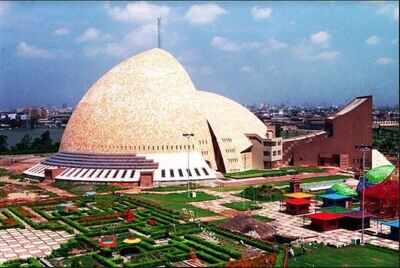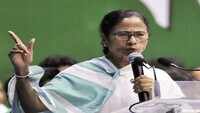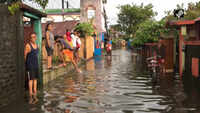
KOLKATA: Faced with acute funds crunch due to zero earnings for over five months, Science City -- the largest science centre in the Indian subcontinent -- has appealed to the Union cultural ministry for a one-time grant of Rs 7.5 crore to tide over the crisis. The latter has forwarded the proposal to the Union finance ministry for approval.
While all museums are facing a revenue issue as they have been closed since mid-March, Science City is the worst hit because unlike the other facilities that get financial support from the government, the science centre here is self-sustaining and meets it's expenses through revenue from gate receipts and renting out conference halls. In 2019-20, Science City had earned Rs 21 crore. But in the first five months of 2020-21, there has been no earning although it has had to fork out nearly Rs 4 crore in salary payment, regular maintenance and ongoing project work.
"The pandemic has left the self-sustaining Science City in a financially stressed situation," National Council of Science Museums director general Arijit Dutta Choudhury admitted.
Science City's founder Dr Saroj Ghose, considered the father of the science centre movement in India, is also worried about the facility's future if the pandemic persists. Developed to draw people in lakhs, it faces an uphill task to adapt to the new normal of social distancing.
Inspired by the Cité des Sciences et de l'Industrie in Paris that was built in an abandoned abattoir, Ghose decided to situate the Science City in Kolkata both indoors and outdoors. “Naturally, it means continued maintenance which is an issue now due to lack of earning," he said.
Ghosh who has set up numerous science facilities and has twice held the prestigious post of president of International Council of Museums (ICOM) in Paris, is learning things anew at the ripe age of 85.
"Science centres were built to transform museums from a viewing experience to an interactive one. Science City made it immersive. The objective was to bridge the urban-rural divide and make science learning accessible to all. Now, the digital divide threatens to revive that gulf by empowering only urban students who have access to internet and online learning," said Ghose.
Creating an online experience is itself a daunting task as there isn't enough digital content beyond still photographs and the odd video. "We are trying to mount some exhibits online. It entails uploading a huge amount of data. But if content is too heavy, it will be difficult to view via a home connection," explained Dutta Choudhury.
Spread over 23 acre, the largest science centre in the Indian subcontinent, draws around 15 lakh visitors each year. When Ghose had conceived it in 1992, he had envisaged how popular it would be and hence refused the then Left Front government's offer to locate it at the 70 acre Salt Lake Central Park. Instead, he wanted an abandoned municipal waste dumpsite next to the EM Bypass.
"Buddhadeb Bhattacharjee, the then cultural minister, doubted if people would visit Science City if it was built at a place that emitted a foul stench as the site then did. He suggested the Central Park instead. I turned it down because I believed Science City would draw visitors by the thousands daily. This would lead to traffic snarls in the township and its residents would curse me," Ghose recounted.
While all museums are facing a revenue issue as they have been closed since mid-March, Science City is the worst hit because unlike the other facilities that get financial support from the government, the science centre here is self-sustaining and meets it's expenses through revenue from gate receipts and renting out conference halls. In 2019-20, Science City had earned Rs 21 crore. But in the first five months of 2020-21, there has been no earning although it has had to fork out nearly Rs 4 crore in salary payment, regular maintenance and ongoing project work.
"The pandemic has left the self-sustaining Science City in a financially stressed situation," National Council of Science Museums director general Arijit Dutta Choudhury admitted.
Science City's founder Dr Saroj Ghose, considered the father of the science centre movement in India, is also worried about the facility's future if the pandemic persists. Developed to draw people in lakhs, it faces an uphill task to adapt to the new normal of social distancing.
Inspired by the Cité des Sciences et de l'Industrie in Paris that was built in an abandoned abattoir, Ghose decided to situate the Science City in Kolkata both indoors and outdoors. “Naturally, it means continued maintenance which is an issue now due to lack of earning," he said.
Ghosh who has set up numerous science facilities and has twice held the prestigious post of president of International Council of Museums (ICOM) in Paris, is learning things anew at the ripe age of 85.
"Science centres were built to transform museums from a viewing experience to an interactive one. Science City made it immersive. The objective was to bridge the urban-rural divide and make science learning accessible to all. Now, the digital divide threatens to revive that gulf by empowering only urban students who have access to internet and online learning," said Ghose.
Creating an online experience is itself a daunting task as there isn't enough digital content beyond still photographs and the odd video. "We are trying to mount some exhibits online. It entails uploading a huge amount of data. But if content is too heavy, it will be difficult to view via a home connection," explained Dutta Choudhury.
Spread over 23 acre, the largest science centre in the Indian subcontinent, draws around 15 lakh visitors each year. When Ghose had conceived it in 1992, he had envisaged how popular it would be and hence refused the then Left Front government's offer to locate it at the 70 acre Salt Lake Central Park. Instead, he wanted an abandoned municipal waste dumpsite next to the EM Bypass.
"Buddhadeb Bhattacharjee, the then cultural minister, doubted if people would visit Science City if it was built at a place that emitted a foul stench as the site then did. He suggested the Central Park instead. I turned it down because I believed Science City would draw visitors by the thousands daily. This would lead to traffic snarls in the township and its residents would curse me," Ghose recounted.

Coronavirus outbreak
Trending Topics
LATEST VIDEOS
City
 Drug link in SSR case: My son wrongly framed, there are bigger names involved, says father of the accused
Drug link in SSR case: My son wrongly framed, there are bigger names involved, says father of the accused  SSR death case: Mumbai Police under lens? Central agencies to probe whether Call Data Records were leaked
SSR death case: Mumbai Police under lens? Central agencies to probe whether Call Data Records were leaked  With a new turn in SSR case, BJP leader Vishwas Sarang demands dope test for actors
With a new turn in SSR case, BJP leader Vishwas Sarang demands dope test for actors  SSR death: Imtiaz Khatri's alleged role in drug mafia-Bollywood nexus needs to be thoroughly probed, says BJP leader Ram Kadam
SSR death: Imtiaz Khatri's alleged role in drug mafia-Bollywood nexus needs to be thoroughly probed, says BJP leader Ram Kadam
More from TOI
Navbharat Times
Featured Today in Travel
Get the app





